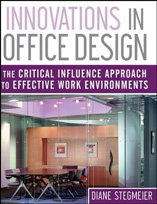Critical Influence™: Technology
The role of technology in your organization’s workplace strategy
In examining the role of technology in a workplace strategy, it is helpful to take a quick stroll down Memory Lane. From corded to cordless telephones to softphone solutions; from fax machines to portable scanners to instant scanning apps; from typewriters to computers and tablets; we could go on and on to document something you already know: that the use of technology in the workplace has come a long way.
It is safe to say that there is no existing workplace that does not use technological tools. We live in a digital age where technology is no longer a matter of choice, it is now considered the lifeblood of businesses.
Most organizations of today describe their work environment as fast-paced and to keep up with the constant sequence of tasks, employees and leaders alike turn to technology for help. Various technological advancements have enabled companies to streamline business processes such as delegation of tasks and communication between team members. Some even automate the basics so that employees can focus on more challenging and creative tasks. It is no surprise that corporate workplace strategies have increasingly made technology a focal point in recent years.
 With the widespread use of the internet, many organizations are also realizing the convenience and increased efficiency brought by remote working. The 21st century has seen an influx of freelancers and remote workers across the globe. With the help of online job search sites, business owners and HR professionals are able to hire talent from anywhere in the world.
With the widespread use of the internet, many organizations are also realizing the convenience and increased efficiency brought by remote working. The 21st century has seen an influx of freelancers and remote workers across the globe. With the help of online job search sites, business owners and HR professionals are able to hire talent from anywhere in the world.
Perhaps, the most valuable advantage technology has brought to the corporate setting is that collaboration among geographically dispersed workforce has been made easier. Cloud-based solutions have made it possible for documents to be easily accessed and edited by authorized individuals. Voice or video conferencing software programs have enabled teams to interact online and share ideas from wherever they may be.

As part of the 15 Critical Influences™, this page on Technology is integrated with actual content from the book Innovations in Office Design: The Critical Influence Approach to Effective Work Environments™ by SCG Founder Diane Stegmeier.
How failed technology can thwart the adoption of a new workplace strategy
It is evident that technology is a primary enabler of enhanced productivity, both in the office and for remote workers. In an organization where mobility and efficiency is valued, employees are provided with the devices, software, and connectivity needed to stay productive no matter where they work.
However, no matter how apparent these technological advantages are in today’s business climate, shortcomings in the optimization of technology still exist in many organizations. When individuals aren’t given the proper technological tools (or trained in how to use them) for a specific line of work, productivity is negatively impacted. For instance, outdated technology or limited connectivity binds employees to their work area when they could be equally productive across the building, campus, or world.
Sometimes inadequate technology is an organizational decision and not mere incompetence.
In 2019, we were hired to develop a workplace strategy for a government client whose office environment was an uninspiring ghost town of 1980’s high-paneled cubicles and private offices. On this project we partnered with an architectural and engineering firm and worked closely with the client’s real estate team to collaborate on developing three different design concepts, each more modern than the last. These workplace concepts sought to fit the unique floor plate of the agency’s current building and improve collaboration between employees.
The design concepts would be aligned with organizational goals and presented internally to an executive steering committee for approval to move ahead with a new workplace strategy for the organization. With a highly-educated workforce and large population nearing retirement, this federal agency recognized the need to revitalize its workplace and introduce a more collaborative approach to work that would appeal to the college students who toured their dated headquarters during the interview process.
This government agency had previously experimented with introducing more collaborative workstyles. A few years prior, an activity-based work pilot space was tested out in one wing of the building by a department. This was rejected by workers after concerns of privacy and audible distractions were raised and the pilot space was ultimately abandoned, with team members returning to their private offices and high-wall cubicles.
In the course of our dialogue and visits, it was uncovered that wireless internet access was not available to employees in the building. With the work of this agency being sensitive in nature, a wifi signal was considered to be a matter of national security. A courtyard shared with another federal agency was reason enough to prevent this client from using wifi technology, with a concern centered around the signal being picked up from anyone in the courtyard.
Within the office, employees were not entirely bogged down to their desks, but without wifi, collaborative work and self-directed individual work (via activity-based work) was and would be largely stifled. Docking stations in conference rooms allowed for team members to get online with their laptops during meetings. But for an organizational shift to activity-based working, such as the pilot attempt or with the design concepts, technology simply can’t be an impediment.
Without wifi, end-users will simply ignore some of the less-traditional work areas we see in modern offices. Bar height tables in kitchenette areas will only be used at meal time. Most employees will simply eat at their desks while doing low-focus tasks instead of dragging an ethernet cable with them to plug in at the table top. Kanban and lounge areas will be avoided in favor of simply using traditional conference rooms for breakout meetings due to the convenience of docking stations.
By investing in a modern office design and eschewing wifi, companies are simply asking for a large portion of their workplace to be under-utilized while at the same time risking conference space being over-taxed by users. In the event of our government client, their security and IT groups pushed back significantly and said that wifi access could not be implemented for at least 18 months due to their workload and process. So even with the proper technology to implement a workplace change, things may run behind schedule.
Not only that, the varying degrees of technical knowledge among the four generations present in the current workforce may also hinder the effective utilization of technology. This is why it is important to understand every generation’s perception of technology in relation to workplace productivity and design.
Technological perception of multiple generations and its impact on workplace strategies
Understanding one generation’s perception of technology must go well beyond interpreting an individual’s level of comfort in using the existing electronic work tools the enterprise provides, or a willingness to learn the latest software embraced by the company.
Bob Johansen of the Institute for the Future has explored the social and organizational impact of new technologies. As a social scientist, he has studied the human aspect of technological advancement. In Get There Early: Sensing the Future to Compete in the Present, he describes the multiple generations’ different perceptions of technology.
“Baby boomers see technology as either tools or toys, or both. Digital youth see technology as an extension of themselves, and they often don’t ‘see’ technology much at all; they just assume it as a part of their being. After more than a decade of widespread Internet use, studies indicate that youth are developing a wide ‘attention range’ and a short ‘attention span.’ That is, they are accustomed to a multimedia and multichannel learning style with frequent interruptions. On the positive side, they are skilled at sharing knowledge and creating social networks online. These skills are the basis for new forms of business practices and client services.”
—ROBERT JOHANSEN
Reflecting on Johansen’s insights on how technology might be perceived differently by members of an organization’s workforce, and then applying them to the design of the physical office space, the architect or interior designer no doubt will notice misalignment between what technology can do and what the client is willing to do with it.
Consider reducing numerous workplace design options to the lowest common denominator to accommodate four different generations. This is a difficult challenge, to be sure. Even the presence of mobile technology and wireless access to data in an organizational culture that truly trusts employees to work wherever they choose does not guarantee that members of the aggregate workforce will be productive.
 Certainly, the “digital youth” identified by Johansen are adept at operating among multimedia influences and interruptions. Conversely, baby boomers often feel distracted by similar influences, and so prefer to have some space between themselves and others, to better focus on their work. That is not to say they cannot multitask—they may indeed be performing a number of different tasks. It is to say they may prefer a quieter space to conduct their activities.
Certainly, the “digital youth” identified by Johansen are adept at operating among multimedia influences and interruptions. Conversely, baby boomers often feel distracted by similar influences, and so prefer to have some space between themselves and others, to better focus on their work. That is not to say they cannot multitask—they may indeed be performing a number of different tasks. It is to say they may prefer a quieter space to conduct their activities.
Keeping this in mind, it is a must for organizational leaders to think how technological tools and the corresponding work spaces will be perceived by employees. Would every member of the workforce find it easy to collaborate using this tool? Is it better to have this particular technology situated in this part of the workplace? What must be done to encourage productivity using this technology?
There is no overstating the importance of providing employees the knowledge that they need on how to utilize spaces in a new work environment and new technology that comes with it. Facilitating training sessions and developing training content are some of the best ways to engage the workforce and help them better prepare for change.
Of course, it is also important to ensure the effectiveness of the new technological tools in the workplace but even that is not enough, proper reinforcement and the consideration of other Critical Influences™ must go with it. How do Critical Influences™ affect the optimization of future technologies in the workplace? Find out in the next section.
How Critical Influences™ affect the optimization of new technologies
Critical Influences™ may raise barriers to the optimization of future technologies that will be invented to share knowledge. Even if the appropriate office or laboratory space is designed for collaboration, and the technology is developed, the organizational culture could become a hindrance to employees’ exchange of data.
If the culture of an enterprise is focused on the “I” rather than on the “we”; if staff members feel their ideas are not fairly recognized by the leaders of teams, departments, or business units; or if managers take credit for the concepts developed by their direct reports; then knowledge exchange within the organization will be stifled.
A company that needs to produce innovations on an ongoing basis to survive in the industry in which it operates could find itself failing in its field if it cannot motivate collaboration and the sharing of knowledge among members of its workforce.
In a joint presentation on “Change Artists,” Bill Weldon the former CEO of Johnson & Johnson, described their initiative called “Links,” where technology was used to reduce the time needed for problem resolution. This initiative perfectly illustrates how collaboration is encouraged through effective reinforcement of technology.
Using the Links program, for example, a scientist can go online within the enterprise and state a problem and ask for help. Other scientists track the questions and respond with potential solutions. Using this technology can generate answers to key issues arising in the development of new drugs in record-breaking time.
The point here is not that Johnson & Johnson has invented a new technological forum in which employees can exchange ideas. Many organizations have done as much. The point is that the system worked at Johnson & Johnson because it was being used.
A similar example is how chat-based community instant messaging programs such as Slack and Discord have become mainstream in tech organizations and are beginning to be embraced by the broader business world. Different ‘channels’ link employees together on various topics of importance and allow for instantaneous support, feedback, and collaboration.
Frequently, organizations develop a process for information exchange between its employees, and generate enthusiasm with the initial launch. But in many cases, the system is not reinforced by the company’s management, and so it goes unused or, at best, is underutilized.
Consulting expertise for technology optimization in a new workplace strategy
If you are facing a significant change in your workplace, don’t leave its success to chance. Stegmeier Consulting Group can help you look into the impact of technology on your new workplace strategy and get employees on board with this change. If this is the type of guidance that you are looking for, reach out to us by filling out the form below.



